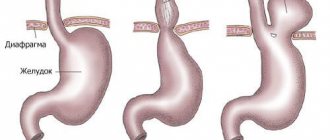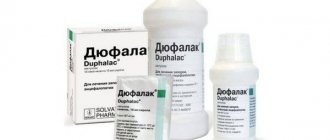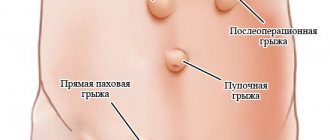What is an intestinal hernia and how to treat it
An intestinal hernia, like any other hernia, is a dangerous disease. In general, this disease is characterized by a condition in which a person’s internal organs emerge, without violating the integrity of their shell, from the place they occupy through existing or pathologically formed openings. Internal organs increase in size and fill anatomical openings under the skin, muscle spaces or internal cavities.
The essence of pathology
An intestinal hernia is a pathological process in which loops of intestine protrude through thin and weak areas of the abdominal wall or cavity - spaces between muscles, postoperative defects in peritoneal tissue. In the normal state, the intestinal loops are located in the abdominal cavity and are held in place by the ligamentous apparatus, and the function of the abdominal wall is to resist intracavitary pressure. If there are weak spots in the peritoneum and an increase in pressure in its cavity, the intestine protrudes and an intestinal hernia is formed.
The exit of part of the intestine in the form of a soft and elastic formation into the abdominal cavity can be seen in a vertical position or palpated with tension. The causes of intestinal hernias can be stretching and thinning of the abdominal wall due to age-related changes in the body, pregnancy, sudden weight loss, ascites and a number of other reasons.
Intestinal hernias are different, it depends on their location:
- An inguinal hernia develops when a section of intestine prolapses into the outer ring of the inguinal canal.
- An umbilical hernia usually appears in newborns due to underdevelopment of the umbilical ring; in adults, this type of hernia can appear in women after pregnancy and childbirth.
- A femoral hernia most often develops in women after forty years of age, as the deep femoral ring ages and becomes thinner with age.
- A hernia of the white line of the abdomen is formed in men, most often it is multiple and painless, the midline of the abdomen is the site of muscle fusion and consists of connective tissue through which the hernial formations emerge.
- Postoperative hernias develop after purulent and inflammatory processes at the site of surgical intervention and require abdominal wall plastic surgery, as they significantly increase in size.
- Some types of hernias can develop when parts of the intestine become trapped in abdominal pockets—sciatic, perineal, or lateral hernias. Such varieties are quite rare.
Hernias can be acquired, congenital, postoperative and traumatic, and are also divided depending on the nature of the disease into reducible and unreducible, complete and incomplete, complicated or uncomplicated.
An intestinal hernia is a pathological process in the body that is characterized by the release of intestinal loops through weak spots in the abdominal wall or abdominal cavity. The role of a hernial orifice can be played by gaps in muscle tissue, intestines or peritoneum, tissue defects after surgical interventions, or enlarged holes in the abdominal wall that arise as a result of pathogenic processes in the body.
Types of intestinal hernias
In medicine, there are several types of intestinal hernia, depending on its location. The most common are umbilical, inguinal and femoral. Less common are the lumbar and sciatic muscles.
Women and children who have given birth are prone to umbilical hernia. Moreover, in children, the pathology is often congenital in nature and arises due to the specific structure of the umbilical ring. Predisposition to this type of hernia is determined by the presence of a peritoneal diverticulum in the area of the umbilical ring.
Inguinal hernia of the intestine is quite common and can be either unilateral or bilateral. There are two types of inguinal hernias: direct and oblique. When a direct hernia occurs, part of the intestine comes out through the outer ring of the inguinal canal; an oblique hernia is characterized by protrusion of a section of intestine through the internal inguinal opening.
The formation of a femoral intestinal hernia is observed in women after forty years. Such protrusion very rarely reaches large sizes, but has a tendency to infringe. Hernias of this type can be complete or incomplete. In the second case, the contents of the hernial protrusion do not leave the fascia and are localized in the femoral ring.
Men often experience a hernia of the linea alba. In this case, the role of the hernial orifice is played by the gaps in the white line of the abdomen. The complexity of such formations lies in the fact that they can be multiple. The protrusions form one on top of the other, the disease can be asymptomatic, obvious signs appear during the period of exacerbation of the hernia.
Another type of intestinal hernia is postoperative. They are formed between the separated tissues of the aponeurosis and muscles. The main reason for their occurrence is a festering wound at the suture site, the introduction of tampons into it and inflammatory processes in the body after surgery.
Sciatic, perineal, obturator and lateral intestinal hernias are very rare. When internal protrusions form, intestinal loops extend into intra-abdominal pockets, the peritoneum can cover only part of the intestine - this is fraught with the occurrence of a sliding hernia.
Causes
Causes of intestinal hernia:
- physical exercise;
- pregnancy, prolonged labor with complications;
- chronic constipation, difficulty urinating;
- severe cough, bronchitis, whooping cough;
- hereditary predisposition to the disease;
- age-related changes in the body, sagging muscle tissue;
- sudden weight loss during fasting or as a result of illness;
- overweight;
- previous abdominal injuries;
- ascites.
In the early stages of the disease, symptoms may be mild or completely absent. When the protrusion increases in size, the patient may feel general malaise and discomfort in the abdominal area.
Types of abdominal hernia
An inguinal hernia is the most common. More than two-thirds of all diagnosed diseases are inguinal, and they develop more often in men over forty against the background of general aging of the body or injuries.
Femoral hernias form at the junction of the abdominal muscles and thighs. Unlike inguinal, they are much more often diagnosed in women.
An epigastric hernia develops due to incompetence of the muscles of the upper middle part of the abdominal cavity. This type of abdominal disease is diagnosed three times more often in men than in the fair sex.
Patients of all ages can boast of umbilical hernias, especially infants and preschoolers.
An incisional hernia appears at the site of a postoperative suture. At the same time, both the fresh inner seam and the old one can “come apart”. This means that pathology at the site of the old incision may develop after several months or years.
Possible complications
Complications develop as a result of late seeking medical help. The most common diagnosis is fecal impaction (obstructive intestinal obstruction). Caused by a bend in the gastrointestinal tract loop. Elastic strangulation (strangulation intestinal obstruction) is also possible. Accompanied by necrosis and rupture of the intestine located in the hernial sac.
A hernia provokes dysfunction of the organs of the system where the hernial sac is located. If the pathology is localized on the white line of the abdomen, the functioning of the digestive system is disrupted. The patient suffers from frequent constipation, and the development of stomach ulcers, gastritis, and colitis is possible.
With an inguinal hernia, diseases of the genitourinary system occur. The most common complication is the irreducibility of the hernial sac. If the size of the protrusion is small, there are no complications, and the person assumes a horizontal position of the body, the wandering hernia is hidden.
This condition is called a wandering hernial sac, because. when the body position changes, the organs that have fallen into the hernial sac return to their normal position. If the patient lies down, but the bulge on the body does not decrease, this indicates the development of a serious complication, which is dangerous because over time the hernia begins to divide into several sectors, and a segment of the intestine falls into each of them.
A hernia provokes dysfunction of the organs of the system where the hernial sac is located.
With the development of an inguinal hernia, the functioning of the small intestine and rectum is completely disrupted. Often, the only method of normalizing the functioning of the digestive organs is an anal colostomy - an operation to create another anal passage.
This pathological condition is characterized by the fact that the hernial sac suddenly becomes trapped in the hernial orifice. Strangulation is an emergency that requires immediate surgical intervention.
Accompanied by severe pain, it can cause gangrene to develop, because When pinched, the blood circulation in the area is disrupted. Other possible complications: intussusception (intestinal obstruction), diverticulosis of the sigmoid colon (formation of pockets in segments of the colon).
If the pathology is localized on the white line of the abdomen, the functioning of the digestive system is disrupted, and the patient suffers from frequent constipation.
The main reasons for the development of intestinal hernias
Intestinal hernia is a general term that refers to several types of protrusion. The most common are umbilical and inguinal protrusions, as well as hernia of the white line of the abdomen. In all cases, intestinal loops protrude through the hernial orifice. All types of intestinal hernias have their own predisposing factors that contribute to their development.
The appearance of an inguinal hernia is predisposed by weakness of the ligamentous apparatus and the muscular frame that supports the pelvic organs in the correct anatomical position. This leads to the fact that gradually part of the intestine shifts into the inguinal canal. Most often, this type of hernia is observed in men. Hernia of the white line of the abdomen is largely due to the anatomical features of the fusion of muscle fibers with connective tissue.
The formation of intestinal hernias is largely due to the anatomical features of the walls of the abdominal cavity, but another aspect of the development of the pathological process should be highlighted. In most cases, an increase in intrauterine pressure is of utmost importance in the process of hernia formation. The reasons for increased intra-abdominal pressure and the formation of intestinal hernia of one type or another are varied. Such predisposing factors for the appearance of a hernia include:
- chronic constipation;
- excessive physical activity;
- intense cough;
- sudden lifting of weights;
- exhaustion of the body;
- pregnancy;
- abdominal trauma;
- excess weight.
A separate group based on etiology includes postoperative hernias, which form against the background of purulent or inflammatory processes that prevent wound healing. After surgery, an intestinal hernia may develop, even if no abnormalities were observed during the recovery period. This may be due to improper healing of the open wound, during which a pocket is formed, which becomes a springboard for the formation of a hernial protrusion.
Prevention
Hernia of the rectum and other parts of the intestine is a serious condition that can be prevented with the help of preventive measures aimed at preventing an increase in pressure inside the abdominal cavity.
The main preventive measures are proper nutrition and eating patterns. Excess weight, caused by unlimited intake of fried and fatty foods, flour and confectionery products, and carbonated drinks, is the main reason for the appearance of a hernial sac.
Frequent overeating leads to increased pressure inside the abdominal wall and can cause a hernia. It is recommended to avoid frequent constipation. If there are frequent bowel movements, it is necessary to identify the cause and carry out appropriate treatment.
Excess weight is the main reason for the appearance of a hernial sac.
People who professionally engage in heavy sports or lift heavy loads due to their professional activities must wear a special bandage during active physical activity.
Muscles must be in good tone, so in order to prevent hernia, you need to make it a habit to exercise regularly.
People who professionally engage in heavy sports or lift heavy loads due to their professional activities must wear a special bandage during active physical activity.
It is recommended to use this device for women from the second trimester of pregnancy, when the rapidly enlarging uterus puts pressure on the abdominal organs, which often causes the development of an inguinal hernia.
Muscles must be in good tone, so in order to prevent hernia, you need to make it a habit to exercise regularly. It could be a simple morning exercise that will help keep your body in shape.
How does an intestinal hernia manifest in men and women?
Intestinal hernia is diagnosed with equal frequency in both men and women. This pathological condition is characterized by protrusion of a loop of intestine through the hernial orifice, which forms on weakened areas of the abdominal wall. The appearance of such a defect in most cases occurs with severe symptoms.
An intestinal hernia is a pathological process in which weakness of the abdominal wall in some places leads to the formation of a hernial orifice and protrusion of intestinal loops. As a rule, the places where hernias form are typical. Modern medicine has developed methods of diagnosis and assistance, but radical treatment remains surgical.
Why is it formed
With a hernia, there is always weakness of the abdominal wall, diaphragm or muscles. In places of defect or tissue deficiency, a hole is formed - a hernial orifice. Parts of various parts of the intestine enter there, which can come out, ending up under the skin, or migrate in the abdominal cavity. In a normal state, the intestinal loops are reliably supported by the ligamentous apparatus, and the abdominal wall protects against intracavitary pressure.
There are two causes of intestinal hernia:
- Tissue weakness
- Increased intra-abdominal pressure.
It is the combination of these factors that most often causes a hernia. Why does the pressure inside the abdomen increase? This can occur under severe stress, for example, when lifting excessive weights, excessive physical activity, and also with certain gastrointestinal diseases. In the latter case, problems that cause bloating play a special role.
However, risk factors are not only diseases of the stomach or intestines. Excessive load on the abdominal wall occurs during pregnancy, sudden weight gain or loss. The characteristics of human connective tissue play a decisive role in the formation of pathology. If there is congenital weakness, then any other adverse effect can quite quickly provoke the appearance of a defect in the abdominal wall and protrusion of part of the intestine. Abdominal surgery can be a damaging factor, especially if the patient did not follow a gentle regimen after the intervention.
With age, natural “wear and tear” of tissues occurs, they become thinner and become less resistant to various influences. For this reason, hernias often develop in older people.
What kind of hernia happens?
Abdominal hernias can be external or internal. With external ones, a protrusion is formed in the form of a hernial sac, which ends up outside the peritoneum, that is, almost under the skin. It is most often visible to the naked eye and can be easily felt. Internal ones are formed inside the abdomen and are located in the folds and pockets of the peritoneum. They also have a hernial orifice and hernial contents, but a hernial sac does not form.
According to the World Health Organization classification of diseases, there is no such disease as intestinal hernia. In everyday life, this concept means that parts of the intestine are contained in a hernial sac, which can form in the following localizations:
- umbilical,
- linea alba,
- inguinal,
- femoral
An intestinal hernia in men is most often caused by a weakness in the wall of the inguinal canal, so it is the inguinal hernia that becomes the cause of intestinal prolapse in them. The anatomical features of the male body favor the formation of defects in this segment. In the female body, the weakest point is the midline of the abdomen, especially during pregnancy, when it is under strong pressure from the expanding uterus.
The symptoms of an external hernia are quite characteristic. First of all, this is a protrusion, which in the initial stages is quite small and is easily set into place. As the pathology develops, it becomes larger and intestinal function may be disrupted. Infringement is especially dangerous, as it threatens the patient’s life if assistance is not provided in a timely manner. If a strangulation occurs, emergency surgery is required.
One of the most common variants of the internal location of this pathology is a hernia of the small intestine. It develops on a fold of the peritoneum and can be true or false. With a true hernia, the walls of the small intestine are completely drawn into the pathological process; with a false hernia, only the mucous and submucosal membranes are involved.
There are no symptoms specific to this disease; they are very similar to many problems of the gastrointestinal tract. This can lead to difficulties in diagnosis. If detected early, treatment with conservative methods is possible. If the process is started, then only surgery will help.
As a result of weakening of the pelvic muscles, a pathology such as rectocele or rectal hernia may develop. This occurs due to weakened perineal muscles, which can no longer reliably fix and hold this section of the intestine. Most often, a rectal hernia occurs in women, since the main cause is frequent constipation and hemorrhoids. It is women who often face such problems, especially after childbirth.
- Tissue injury in this area
- Mechanical impact during surgical treatment.
As soon as the muscles weaken and the rectum protrudes beyond the anus, the patient feels discomfort. Problems arise with bowel movements, pathological constipation becomes regular, and pain appears in this area.
External hernias are easily diagnosed by examining and palpating the affected area. To clarify, an ultrasound examination may be necessary. To make a diagnosis, ultrasound will be the most important diagnostic method.
Treatment should be started as early as possible to avoid dangerous complications. Radical treatment is only possible through surgery. If a hernia is diagnosed, treatment with traditional methods can only be supportive. It will not get rid of the pathology, because tissue defects in the form of a hernial orifice can only be eliminated through surgery.
Symptoms
An intestinal hernia initially develops without acute manifestations. Then the symptoms become pronounced and increasing.
List of symptoms:
- The manifestation of a characteristic knob-like protrusion, which disappears in a supine position (in irreducible forms is noticeable in any position).
- Reflux esophagitis. As a result of pinching, an acidic environment is thrown into the esophagus from the stomach. This provokes damage to the mucosa and a destructive effect on enzymes. Heartburn, pain in the abdomen and chest appear. It worsens immediately after eating, in stressful situations and at night.
- Pain syndrome in the form of contractions, tingling, dull pulling sensations. May be periodic or regular.
- A feeling of fullness even after a bowel or bladder movement.
- Constipation and difficulty defecating.
- General weakness, elevated body temperature, chills.
Treatment
Numerous studies in the field of abdominal surgery have shown that conservative treatment of hernias is completely ineffective. If an uncomplicated abdominal hernia is detected in a patient, a planned hernia repair is indicated; if the hernia is strangulated, emergency surgery is required. All over the world, more than 20 million surgical interventions for abdominal hernia are performed annually, of which about 300 thousand are performed in Russia. In developed countries, for every 9 planned interventions there is 1 operation for a strangulated hernia; in domestic clinics the indicators are slightly worse - for every 5 planned hernia repairs there is 1 urgent operation. Modern methods of diagnosis and surgical treatment of abdominal hernia are aimed at early detection of this pathology and prevention of complications.
Conservative treatment (wearing a bandage) is indicated only in cases where surgery is impossible: in elderly and malnourished patients, pregnant women, and in the presence of oncological pathology. Wearing a bandage for a long time helps to relax the muscle corset and provokes an increase in the size of the hernia, so it is usually not recommended.
Planned hernia repair
In previous years, classical methods of hernia repair prevailed, which consisted of suturing the hernial orifice and closing it with one’s own tissue. Currently, more and more surgeons are using tension-free hernioplasty techniques, which use special synthetic meshes. Such operations are more effective; after their use, recurrences of abdominal hernia practically do not occur.
If a hiatal hernia is detected in a patient, various operations are used (endoscopic fundoplication, gastrocardiopexy, Belsey operation) to reduce the hernial orifice and prevent the movement of abdominal organs into the pleural cavity.
Surgeries to eliminate external abdominal hernias can be performed under local anesthesia, including using endoscopic techniques. For any type of hernia repair, the hernial sac is first opened and the internal organs (the contents of the hernia) are examined. If the intestinal loops and other organs trapped in the hernial sac are viable, they are reduced into the abdominal cavity and a hernial orifice repair is performed. For each type of hernia, its own surgical technique has been developed, and the scope of surgical intervention in each case is developed individually.
Emergency hernia repair
If emergency hernioplasty of a strangulated hernia is performed, examination of the intestinal loops may reveal necrosis, perforation with incipient peritonitis. In this case, surgeons switch to an extended laparotomy, during which the abdominal organs are inspected and necrotic parts of the intestine and omentum are removed. After any operation for hernia repair, wearing a bandage, dosed physical activity only with the permission of the attending physician, and following a special diet are recommended.
The only treatment is surgery. This pathology is not able to “grow back”, and the hole in the muscle wall is not able to heal on its own. Over time, the hernial orifice will only increase, and in proportion to it, the risk of organ entrapment.
The only type of hernia that can disappear on its own is the umbilical hernia in children under 5 years of age. All other types of disease require surgical intervention, regardless of the stage of development. However, it should be remembered that the earlier the operation is performed, the less likely the occurrence of various complications and the more effective the treatment.
The treatment consists of placing a kind of patch on the hernial orifice made of a special material - an allograft, which fuses with the muscle tissue, preventing the hernia from developing again. The percentage of disease relapses after such an operation does not exceed 1-2%.
Considering the possibility of a loop of intestine becoming pinched in the hernial sac, such a defect cannot be ignored. Making a diagnosis for intestinal hernia is not currently very difficult. As a rule, examination of the patient and analysis of existing complaints is sufficient to determine the nature of the existing problem.
The treatment tactics for intestinal hernia largely depend on the characteristics of the existing formation and the general condition of the patient’s body. In some cases, such formation can be eliminated using conservative methods. If the hernia is small in size, it can be repaired without surgery. The patient may be prescribed a diet, wearing a special bandage and performing certain exercises. Conservative treatment methods may not have a positive effect in all cases.
In most cases, surgical intervention is required to eliminate the hernial sac, the type of which is determined individually. During surgery, the contents of the sac are repositioned. If the loaded gate is small, hernioplasty can be performed, in which the existing defect is closed with its own tissues. In addition, ligation of the hernial sac in the cervical area is often performed to prevent re-perforation of the reduced contents.
In cases where these 2 methods of surgical treatment are ineffective, the contents of the hernia are reduced and the existing defect is closed with a special polypropylene mesh. This method of surgical treatment of hernia is considered one of the most effective, as it allows you to create a strong frame on which your own muscle and connective tissue subsequently grows. This type of surgery minimizes the risk of hernia recurrence in the future.
Hernia of the cecum, large, small and other parts of the intestine, depending on the stage of development of the pathological process, is treated with conservative methods or with the help of surgery.
Medicines are aimed at relieving the painful symptomatic picture and preventing further development of the pathological process. But you can completely get rid of a hernia only through surgery.
If the bag does not increase in size and there are no complications, the patient is prescribed physical therapy aimed at strengthening the muscle corset to prevent further organ loss. A bandage must be worn.
Traditional medicine methods and herbal decoctions in the treatment of this pathological condition are used only as additional therapy to reduce the intensity of the pain symptom. Conspiracies in the treatment of hernia will not give any effect.
Medicines are aimed at relieving the painful symptomatic picture and preventing further development of the pathological process.
If the bag does not increase in size and there are no complications, the patient is prescribed physical therapy aimed at strengthening the muscle corset to prevent further organ loss.
Traditional medicine methods and herbal decoctions in the treatment of this pathological condition are used only as additional therapy to reduce the intensity of the pain symptom.
Treatment of gastrointestinal hernias in adult patients is carried out surgically. Conservative methods do not bring the necessary therapeutic results. The exception is newborn children. As a rule, umbilical hernias are diagnosed in infants, which go away on their own by about 3–5 years of the child’s life.
Surgical treatment
The operation takes place under general anesthesia. During the procedure, the intestinal loop is reduced and the hernial orifice is sutured. In case of necrosis of the contents of the hernial sac, the dead area is removed, followed by connection of the intestine.
Surgeons correct the intestinal loop that has protruded beyond the anterior wall and suture the hernial orifice, preventing re-formation of the hernia
If it is impossible to perform a herniotomy operation, the following options are used:
- Wearing a bandage. The use of corrective medical underwear helps support weak muscles and slows down the progression of pathology. Each model is equipped with a solid part that provides high-quality support for the hernia.
- Physiotherapy. Effective in the early stages of pathology.
- Physiotherapy. Recommended in the initial stages.
The absence of relapse largely depends on competently performed plastic surgery. To eliminate the hernial orifice, the patient’s own tissue or a special medical mesh can be used. The second option is more functional. In addition, the body reacts positively to its material and rejection does not occur.
Traditional medicine recipes help alleviate current symptoms, but cannot be an alternative to surgical treatment. The following recipes have worked well. Applying oven-baked onions to the surface of the hernia. Course duration – 3 weeks. Pour boiling water (200 ml) over horse sorrel roots (10 grams) or oak bark (10 grams) and cook for 10 minutes.
The resulting decoction is used for compresses for 10 days. The duration of the procedure is 30 minutes. This prevents the hernia from increasing in size. The following methods are also used. Wash the plantain seeds, dry until flowable and grind. Eat a pinch every day.
Nettle leaves can be applied to the surface of the hernia. The duration of treatment is no less than a calendar month. You need to take a leaf of sauerkraut and apply it to the site of the hernial sac. Or soak a piece of soft cloth in brine and use it as a compress.
Diagnostics
It is very important to immediately consult a doctor upon discovering the first symptoms of an intestinal hernia. This will not only shorten the duration of the proposed treatment, but also get rid of significant deterioration of the condition caused by complications. The examination is carried out by specialized proctologist and gynecologist if the patient is a woman.
To detect the disease, a thorough examination of the patient is carried out, followed by tests.
For detailed research, various methods are used:
- Palpation. The easiest way to determine a hernia in a patient. Perhaps already at the first request. It is a pinpoint palpation of the affected area for the purpose of further diagnosis.
- Magnetic resonance imaging (MRI). It is one of the most accurate methods for determining the size and structure of a formation. Allows you to detect the disease even in the early stages.
- Ultrasound examination (ultrasound). Less accurate than MRI. However, it also allows you to assess the location and size of the hernia.
- Radiography. Gives an understanding of the features of the neoplasm.
To obtain a complete picture of the course of the disease, the doctor, as a rule, uses several methods in combination.










